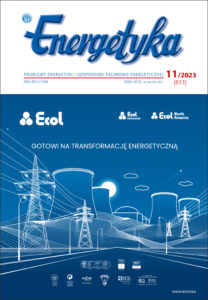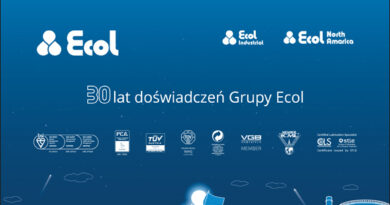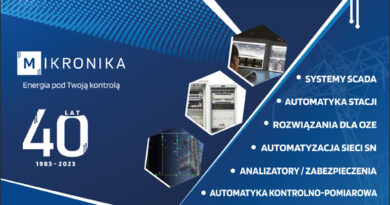November 2023, Issue 11 (833)
TABLE OF CONTENTS
BULLETIN OF INSTITUTE OF ENERGY AND FUEL PROCESSING TECHNOLOGY
Rafał Fryza, Janusz Lasek, Jarosław Zuwała
Will ammonia be the 21st century crude oil?
Małgorzata Wojtaszek-Kalaitzidi, Edyta Misztal, Jarosław Zuwała
Energy storage. Pros and cons of using waste biomass
as a precursor material in electrode production
POWER ENGINEERING AND PRODUCTION COMPANIES
Dariusz Laskowski
Effective field data collection on technical infrastructure with support of artificial intelligence
DESIGN, RENOVATION INNOVATIONS AND MODERNIZATIONS IN THE ENERGY INDUSTRY
Ihor Dzioba, Sebastian Lipiec, Grzegorz Świt, Anna Adamczak-Bugno, Aleksandra Krampikowska
The influence of notch shape on the stress distributions and failure character of samples made of S235 steel
Joanna Furmanek, Janusz Dobrzański
Service life of steam turbine rotor material made of low-alloy Cr-Mo-V
Joanna Furmanek, Janusz Dobrzański, Hanna Purzyńska
High-chromium martensitic steel for steam turbine rotors for operation in power units with supercritical parameters
Grzegorz Golański, Klaudia Klimaszewska, Hanna Purzyńska, Adam Zieliński, Marek Sroka, Mirosława Pawlyta
Possibility of predicting the state of precipitation processes in austenitic steels
Arkadiusz Grzywa, Aleksandra Szmit
Measurement of creep deformation in 13HMF steel using fiber optic sensor and Rayleigh backscattering phenomenon
Tymoteusz Jung, Hanna Purzyńska, Janusz Dobrzański
Hydroid destruction processes on the example of materials working in high-pressure installations
Henryk Kania, Anżelina Marek, Aleksandra Kupczyk, Mateusz Wiewióra, Michał Zoran, Marcin Spławski, Przemysław Kupczyk
Structure and growth kinetics of Zn-5Al coatings on Sebisty’s steel
Marek Nowak, Mateusz Wróbel
Practical application of the Small Punch Test method in the diagnosis of pressure equipment
Tadeusz Pała, Ihor Dzioba, Wiktor Wciślik
Mechanical properties of joints welded using TIG and laser methods from low-carbon steels used in the energy industry
Hanna Purzyńska, Janusz Dobrzański
Creep tests in material diagnostics of pressure equipment and determination of the time of their safe operation
Hanna Purzyńska, Janusz Dobrzański, Adam Zieliński
New high-chromium martensitic steel for power boiler elements for operation in creep conditions above 600oC
Andrzej Rusin, Martyna Tomala
Elements of the strategy for further operation of coal power units ensuring the reliability of energy supplies through the power system
Marek Saňka
Optimization of operation process and implementation of the digital twin of the EKOL turbine in energy block Domoradice
Michał Urbańczyk, Janusz Adamiec
The application of laser technologies for joining two-layer tubes used in the energy industry
Stanislav Veselý
The effect of mixing natural gas and hydrogen on the operation of combustion turbines and blowers
COLUMNS ON TIME
Bogumił DUDEK
Oppenheimer
SUMMARIES
Rafał Fryza, Janusz Lasek, Jarosław Zuwała
Will ammonia be the 21st century crude oil?
The future of the ammonia and hydrogen market in the EU is considered in this article. A comparison of the properties of hydrogen and ammonia was made, including a comparison of their advantages and disadvantages. Ammonia properties was compared with other vehicle fuels. The volume of ammonia production in the EU is presented and the ammonia hubs are mentioned. Available technological pathways for green ammonia production and ammonia applications are indicated. The „RePowerEU” plan as the EU’s response to Russia’s unprovoked and unjustified military aggression against Ukraine, which aims to adopt more ambitious targets and accelerate energy transition and industrial decarbonization, was discussed. In contrast, Japan’s Ammonia Roadmap, which relies on the co-firing of ammonia in thermal power plants and as fuel for ship propulsion, was also introduced. ITPE’s activities in ammonia application as an energy carrier (including the „MethaHydrAmmon” project) were also discussed. It was explained that ammonia and hydrogen should be considered as possible energy carriers from the entire palette of available solutions. However, they should be treated as one, but not the only energy carriers and only up to a certain share in the overall energy mix to ensure diversification and energy security
Małgorzata Wojtaszek-Kalaitzidi, Edyta Misztal, Jarosław Zuwała
Energy storage. Pros and cons of using waste biomass as a precursor material in electrode production
At the Institute of Fuel and Energy Technology, research was conducted with the aim of selecting and evaluating various precursors derived from raw and waste biomass for their potential use in the production of SC electrodes or matrices for heat carriers in multiphase systems. Materials from the tobacco industry, RDF, straw pellets, and MDF (Medium-Density Fiberboard) furniture waste were among those tested. Waste biomass subjected to modifications such as pyrolysis, activation, ion modification with Cu and Ag, exhibited highly favorable and promising properties. The research allowed for the determination of morphology (SEM, optical), assessment of the susceptibility to modifications of individual materials, as well as their stability, specific surface area, and porosity.
Ihor Dzioba, Sebastian Lipiec, Grzegorz Świt, Anna Adamczak-Bugno, Aleksandra Krampikowska
The influence of notch shape on the stress distributions and failure character of samples made of S235 steel
This study attempts to assess the influence of notch shape on the stress distributions and failure character of steel specimens taken from the gas pipeline infrastructure (S235 steel). The analyses were based on the results of different research approaches: the results of laboratory tests with recording of acoustic emission (AE) signals and the results of numerical simulations using the finite element method. This made it possible to determine the nature of the stress development in the specimens with the applied load and to determine the critical values at failure. These data can be used to define the failure criterion of the steel analysed.
Joanna Furmanek, Janusz Dobrzański
Service life of steam turbine rotor material made of low-alloy Cr-Mo-V
The article presents the results of tests of materials for steam turbine rotors made of low-alloy Cr-Mo-V steels with various degrees of depletion. The aim was to determine the suitability of these materials for further use after exceeding the design operating time. The state of the microstructure was evaluated based on revealed images of the structure in the scanning electron microscope and the degree of development of the separation processes based on the X-ray analysis of the phase composition of the carbide deposits. The functional properties were evaluated based on the obtained results of mechanical properties at room and elevated temperatures, as well as the determined residual and residual disposable durability in abbreviated creep tests and creep rates from creep curves for temperature and stress parameters corresponding to operational ones. A scheme of changes in the structure of the tested steels related to the degree of exhaustion was proposed.
Joanna Furmanek, Janusz Dobrzański, Hanna Purzyńska
High-chromium martensitic steel for steam turbine rotors for operation in power units with supercritical parameters
The results of tests on the structure and strength properties of steel at room and elevated temperatures, including creep strength, X12CrMoWVNbN10-1-1 and 9Cr-1.5Mo-1Co-0.3V-NbBN (FB2) steels for turbine rotors for supercritical operation are presented and compared with those for P92 steel.
Grzegorz Golański, Klaudia Klimaszewska, Hanna Purzyńska, Adam Zieliński, Marek Sroka, Mirosława Pawlyta
Possibility of predicting the state of precipitation processes in austenitic steels
Precipitation processes in creep-resisting austenitic steels constitute the main mechanism of degradation of their microstructure and functional properties. Predicting the phase composition of precipitates using the time-temperature-precipitation curve can be helpful for the estimation of safe service time for elements made of these materials.
Arkadiusz Grzywa, Aleksandra Szmit
Measurement of creep deformation in 13HMF steel using fiber optic sensor and Rayleigh backscattering phenomenon
Measuring the creep strain of elements operating at elevated temperatures is difficult to achieve using standard extensometric methods. In this study, a system based on single-mode fiber optic sensors combined with an optical spectrum analyzer based on the Rayleigh backscatter phenomenon was developed for long-term measurement of creep phenomenon under high temperature conditions. The fiber optic measurement system HT-FOLLMS (High Temperature – Fiber Optic Long Life Measurement System) was so stable that that made it possible to carry out a full creep test up to rupture of the sample tested at a temperature of 560oC for a period of two years (720 days).
Tymoteusz Jung, Hanna Purzyńska, Janusz Dobrzański
Hydroid destruction processes on the example of materials working in high-pressure installations
The influence of the presence of hydrogen in steel with a ferritic matrix on hydrogen embrittlement and the simultaneous effects of hydrogen and creep in an alloy with an austenitic structure are discussed, using examples of selected elements of long-term operated installations in the energy and petrochemical industries.
Henryk Kania, Anżelina Marek, Aleksandra Kupczyk, Mateusz Wiewióra, Michał Zoran, Marcin Spławski, Przemysław Kupczyk
Structure and growth kinetics of Zn-5Al coatings on Sebisty’s steel
The article presents the results of research on the formation of Zn-5Al coatings on Sebisty’s steel. The growth kinetics of the coatings at a temperature of 440oC were determined. The microstructure (SEM) was revealed, an EDS microanalysis was performed in characteristic micro-areas and the phase composition was determined (XRD) on the cross-section of the coatings. It was found that the growth of the coating corresponds to a parabolic course and its structure is layered, consisting mainly of the Zn-Al eutectic and the FeAl3 intermetallic.
Marek Nowak, Mateusz Wróbel
Practical application of the Small Punch Test method in the diagnosis of pressure equipment
Safety operation of technical equipment is an ongoing problem in the energy, petrochemical and chemical industries. For failure-free operation of devices, it is important to provide information about the condition of the material of the device being tested using various research methods, sometimes there are very invasive. An alternative is to use the Small Punch Test (SPT) method. The article presents examples of the use of the SPT method in industrial practice to determine the mechanical properties of equipment in the energy and petrochemical industries and the possibility of using the method to determine the ductile to brittle transition temperature. Additionally, the collected material allowed for additional tests, i.e. microstructure tests using a microscope and scanning electron microscope, as well as hardness measurements.
Tadeusz Pała, Ihor Dzioba, Wiktor Wciślik
Mechanical properties of joints welded using TIG and laser methods from low-carbon steels used in the energy industry
The article summarizes the results of butt tests of welded joints made using the laser and conventional TIG methods. The materials welded were chrome-molybdenum steels of the grades 16Mo3 and 13CrMo4-5. The tests carried out included determining the distribution of hardness, mechanical properties and crack resistance in individual sections of welded joints. The obtained results confirmed that the laser welding technologies used, similar to conventional ones, enable obtaining welded joints of good quality and durability.
Hanna Purzyńska, Janusz Dobrzański
Creep tests in material diagnostics of pressure equipment and determination of the time of their safe operation
Short rupture tests and creep tests in the assessment of residual life and residual available life of materials after long-term operation in creep conditions. Creep testing machines enabling these tests to be performed under strict temperature requirements.
Hanna Purzyńska, Janusz Dobrzański, Adam Zieliński
New high-chromium martensitic steel for power boiler elements for operation in creep conditions above 600oC
A new high-chromium steel was proposed for the coils of higher stages of the steam superheater, with creep resistance comparable to the austenitic TP347HFG steel and other mechanical properties corresponding to P92 steel.
Andrzej Rusin, Martyna Tomala
Elements of the strategy for further operation of coal power units ensuring the reliability of energy supplies through the power system
Ensuring the safe operation of the energy system in Poland over the next dozen years requires maintaining a certain number of coal units in the system, for which, in turn, it is necessary to develop a strategy for their further operation in conditions of increased flexibility. The article presents examples of necessary actions that should allow further operation while maintaining an appropriate level of safety.
Marek Saňka
Optimization of operation process and implementation of the digital twin of the EKOL turbine in energy block Domoradice
The article in the first part introduces the realized modern method of steam turbine operation optimization for changed operation modes of CHP according to the operator’s request, using current knowledge of determining long-term safe limit operating modes of the steam turbine. In the second part, the article focuses on the presentation of the realized pilot implementation of the digital twin of the turbine into the control system of the energy block, which provides operators with advanced monitoring and control of operation to minimize the negative impacts of drawing the life of the turbine.
Michał Urbańczyk, Janusz Adamiec
The application of laser technologies for joining two-layer tubes used in the energy industry
The article presents the results of a study on the application of laser technologies for the butt jointing of two-layer tubes (composite tubes) used in the energy industry, eg. waste combustion plants. The tests involved two-layer tubes made of steel 3R12/4L7 and Sanicro 38/4L7 (ø 63.5×6.53 mm) produced by the Alleima company.
Stanislav Veselý
The effect of mixing natural gas and hydrogen on the operation of combustion turbines and blowers
The natural gas transit system from Asia and Eastern Europe to the Czech Republic and Germany is equipped with compression stations that use, among others, GT750-6 gas turbines and TD-260-14-1M/TS turbocompressors as drive units. These machines were manufactured in the Czech Republic and EKOL is continuously upgrading them. As the European Commission promotes the use of hydrogen as a priority within the European Union’s decarbonisation policy, NET4GAS aims to gradually mix hydrogen with natural gas, with the aim of switching to burning pure hydrogen after 2040. The results of cycle calculations of the GT750-6 combustion turbine on natural gas fuel and on natural gas + hydrogen fuel will be presented.




